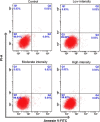A Novel Mechanical-Based Injective Hydrogel for Treatment with Aromatase Inhibitors Caused Joint Inflammation via the NF-κB Pathway
- PMID: 34056178
- PMCID: PMC8153782
- DOI: 10.1021/acsomega.1c00580
A Novel Mechanical-Based Injective Hydrogel for Treatment with Aromatase Inhibitors Caused Joint Inflammation via the NF-κB Pathway
Abstract
Synovium has widely participated in induced inflammation, suggesting that it is a potential target to reduce aromatase inhibitors (AIs) causing joint inflammation or pain. Exercise and mechanical stimulation are important strategies for precaution and treatment of bone inflammation. In this work, we developed a novel thermo-sensitive hydrogel, which could be injected intra-articularly. The aim of this research was to investigate the role of various mechanical strength hydrogels in reducing synovium inflammation. The effect of different mechanical strength hydrogels on regulating synovium inflammation was used to stimulate human fibroblast-like synoviocytes (FLS) under a cyclic mechanical compression environment in vitro. Cytokine and metalloprotease expression in FLS was analyzed by the western blot and q-PCR method, in which FLS were cultured with the different mechanical strength hydrogels. The results showed that a moderate-intensity hydrogel mechanical stimulation might be suitable in reducing AI-induced FLS inflammation via the NK-κB pathway. In addition, we built an AI-treated rat model and injected the different mechanical strength hydrogels. Similarly, the moderate-strength mechanical hydrogel could reduce the inflammatory factor and metalloproteinase expression in synovial tissues and intra-articular synovia.
© 2021 The Authors. Published by American Chemical Society.
Conflict of interest statement
The authors declare no competing financial interest.
Figures






Similar articles
-
Cadherin-11 cooperates with inflammatory factors to promote the migration and invasion of fibroblast-like synoviocytes in pigmented villonodular synovitis.Theranostics. 2020 Aug 21;10(23):10573-10588. doi: 10.7150/thno.48666. eCollection 2020. Theranostics. 2020. PMID: 32929367 Free PMC article.
-
Cannabinoid receptor type 2 is upregulated in synovium following joint injury and mediates anti-inflammatory effects in synovial fibroblasts and macrophages.Osteoarthritis Cartilage. 2021 Dec;29(12):1720-1731. doi: 10.1016/j.joca.2021.09.003. Epub 2021 Sep 17. Osteoarthritis Cartilage. 2021. PMID: 34537380 Free PMC article.
-
Dexamethasone-Loaded Thermosensitive Hydrogel Suppresses Inflammation and Pain in Collagen-Induced Arthritis Rats.Drug Des Devel Ther. 2020 Oct 5;14:4101-4113. doi: 10.2147/DDDT.S256850. eCollection 2020. Drug Des Devel Ther. 2020. PMID: 33116399 Free PMC article.
-
Down-regulating peroxisome proliferator-activated receptor-gamma coactivator-1 beta alleviates the proinflammatory effect of rheumatoid arthritis fibroblast-like synoviocytes through inhibiting extracellular signal-regulated kinase, p38 and nuclear factor-kappaB activation.Arthritis Res Ther. 2014 Oct 24;16(5):472. doi: 10.1186/s13075-014-0472-6. Arthritis Res Ther. 2014. PMID: 25367151 Free PMC article.
-
Local treatment with the selective IkappaB kinase beta inhibitor NEMO-binding domain peptide ameliorates synovial inflammation.Arthritis Res Ther. 2006;8(4):R86. doi: 10.1186/ar1958. Arthritis Res Ther. 2006. PMID: 16684367 Free PMC article.
Cited by
-
Controllable Preparation and Research Progress of Photosensitive Antibacterial Complex Hydrogels.Gels. 2023 Jul 13;9(7):571. doi: 10.3390/gels9070571. Gels. 2023. PMID: 37504450 Free PMC article. Review.
-
The Recent Progress of the Cellulose-Based Antibacterial Hydrogel.Gels. 2024 Jan 29;10(2):109. doi: 10.3390/gels10020109. Gels. 2024. PMID: 38391439 Free PMC article. Review.
References
-
- Wright L. E.; Harhash A. A.; Kozlow W. M.; Waning D. L.; Regan J. N.; She Y.; John S. K.; Murthy S.; Niewolna M.; Marks A. R.; Mohammad K. S.; Guise T. A. Aromatase inhibitor-induced bone loss increases the progression of estrogen receptor-negative breast cancer in bone and exacerbates muscle weakness in vivo. Oncotarget 2017, 8, 8406–8419. 10.18632/oncotarget.14139. - DOI - PMC - PubMed
LinkOut - more resources
Full Text Sources
Other Literature Sources

